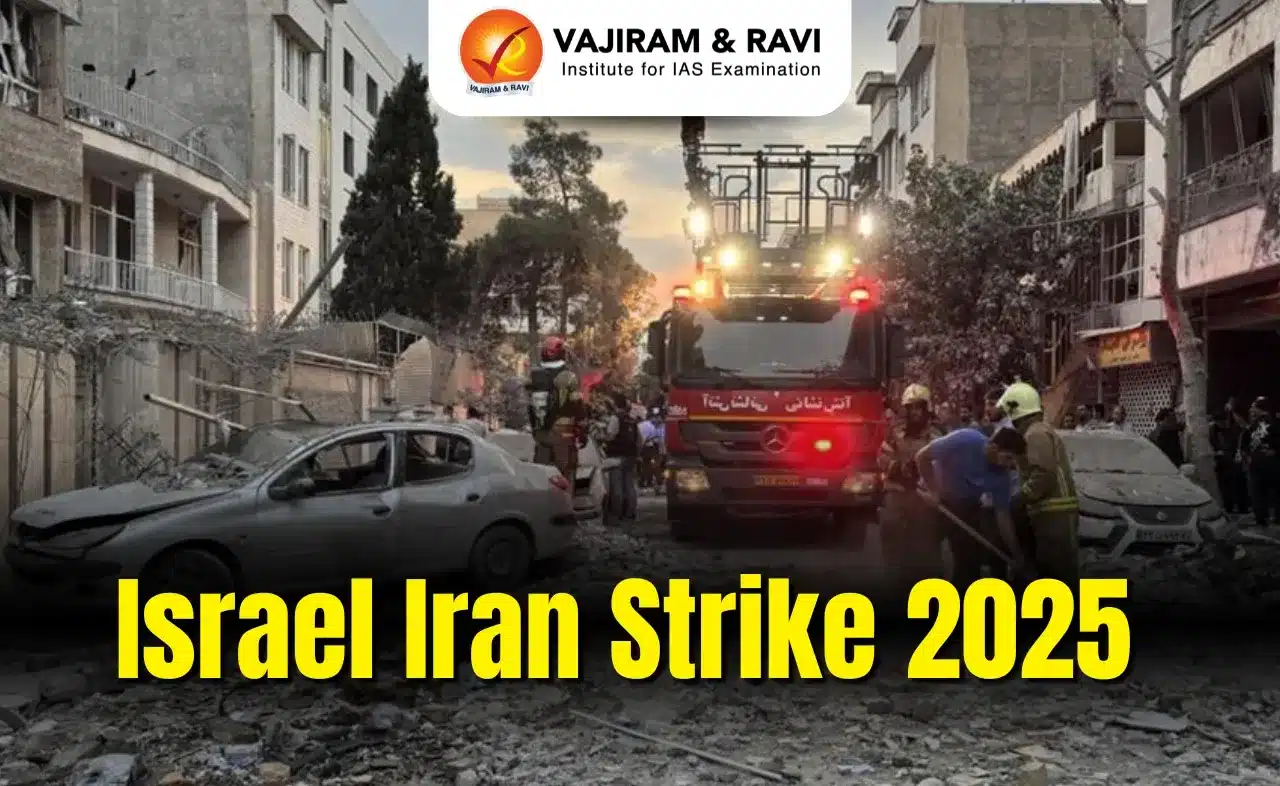Israel Iran Strike 2025 Latest News
- On June 13, 2025, Israel launched a major strike on Iran, targeting nuclear and military sites in Tehran, killing Iran’s Revolutionary Guard chief and two top nuclear scientists.
- The attack marks a dramatic escalation in the Israel-Iran shadow war, raising fears of a broader regional conflict amid growing tensions over Iran’s advancing nuclear programme.
Iran's Nuclear Programme
- Iran claims its nuclear programme is dedicated solely to civilian and peaceful purposes, such as energy production and medical research.
- It operates multiple nuclear facilities across the country, some of which were recently hit in Israeli strikes.
Global Skepticism Persists
- Despite Iran’s assertions, many countries and the IAEA remain unconvinced, suspecting military dimensions to the programme.
- Concerns centre on Iran’s lack of transparency and its refusal to fully explain the presence of undeclared nuclear material.
IAEA Declares Non-Compliance
- For the first time in two decades, the IAEA Board of Governors formally declared Iran in breach of its nuclear non-proliferation obligations.
- The resolution cited multiple failures, including the lack of credible answers regarding nuclear activities and stockpiles.
Near-Weapons-Grade Enrichment
- Earlier IAEA reports revealed that Iran has enriched uranium up to 60% purity, dangerously close to the 90% threshold needed for weapons.
- This stockpile could, in theory, be used to produce up to nine nuclear bombs, raising alarm across the international community.
Israel’s Long-Planned Strike Comes to Fruition
- Israel’s attack on Iran marks the culmination of years of planning. Long opposed to the 2015 nuclear deal, Israel had already carried out clandestine operations.
- This includes the 2020 assassination of nuclear scientist Mohsen Fakhrizadeh and the 2014 bombing of Iran’s embassy in Damascus.
- The latest assault targeted Iran’s nuclear sites, missile facilities, residences of top generals, and over two dozen scientists—making it the most severe blow to Iran since the 1979 revolution.
The Fall of Assad and the Collapse of Iran’s Regional Axis
- The regional power dynamic shifted dramatically after Hamas's October 7, 2023, attack on Israel.
- Israel’s response included strikes on Gaza, Hezbollah in Lebanon, and Syrian forces.
- The fall of Syrian President Bashar al-Assad in December 2024—who had served as a strategic bridge between Tehran and Hezbollah—severely weakened Iran’s deterrence network, known as the “axis of resistance.”
- With this axis dismantled and Iranian defences exposed, Israel saw a narrow window to strike.
Trump's Return and the Strategic Shift
- President Donald Trump’s re-election introduced a new but aggressive diplomatic posture.
- Though he initially delayed Israel's planned May attack to explore negotiations, his administration aimed to force Iran into a new deal that eliminates its nuclear program entirely.
- With talks stalling, Trump backed the June Israeli strike, using it as leverage.
Rising Tensions and Immediate Fallout
- The escalation triggered an 8% surge in global oil prices, raising fears of prolonged instability and global supply chain disruptions.
India’s Energy Vulnerability
- India, which imports over 80% of its crude oil, faces serious risks even though direct imports from Iran are limited.
- Global price hikes and potential supply chain disruptions could significantly increase import costs, impacting inflation and energy security.
Strait of Hormuz: A Strategic Chokepoint
- About 20% of global oil trade passes through the Strait of Hormuz, situated between Iran and the Arabian Peninsula.
- Conflict in this area could disrupt oil supplies from Iraq, Saudi Arabia, and the UAE—India’s key energy partners.
Export Routes and Shipping Costs Affected
- Rising conflict could close access to the Suez Canal and Red Sea, forcing Indian exporters to reroute via the Cape of Good Hope, adding 15–20 days of travel time and raising container costs by 40–50%.
Oil Prices May Stabilise, But Gold Surges
- Experts predict the oil market will stabilise, citing ample global reserves and diversified supply.
- However, gold prices soared above ₹1 lakh per 10g, as investors moved towards safe-haven assets amid geopolitical uncertainty and broader inflationary fears.
Israel Iran Strike 2025 FAQs
Q1: Why is Israel opposed to Iran-US nuclear talks?
Ans: Israel sees Iran’s nuclear program as a threat and prefers military action over negotiations or enrichment concessions.
Q2: What did the IAEA report on Iran reveal?
Ans: It declared Iran non-compliant, citing secret nuclear activities and increasing enriched uranium levels, prompting international concern.
Q3: What is the status of Iran-US nuclear negotiations?
Ans: Talks are ongoing. Iran insists on sovereign enrichment; the US deems it unacceptable. Neither side has walked away.
Q4: What happens if Iran leaves the NPT?
Ans: It would collapse the talks. US law prevents nuclear concessions to non-NPT countries, killing diplomatic efforts.
Q5: How does Netanyahu’s domestic situation affect foreign policy?
Ans: Facing political pressure, Netanyahu may escalate tensions with Iran to avoid elections and rally national support.




